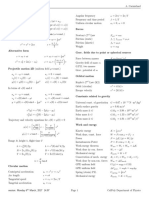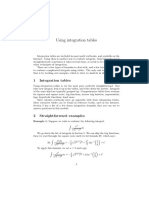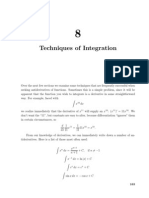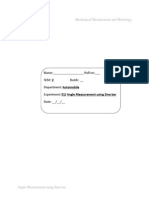Trigonometry Reduction Formula
Uploaded by
Seah JiaChinTrigonometry Reduction Formula
Uploaded by
Seah JiaChinLecture 3:: Trigonometric Substitutions Revisited
0.1
Reduction Formulae:
One idea which is useful is that of a reduction formula. The basic idea is to reduce an integral to a similar integral of lower order. For example: to compute sinn (x) we might do the following sinn (x)dx n sinn (x)dx sinn (x)dx = cos(x) sinn1 (x) + (n 1) = cos(x) sinn1 (x) + (n 1) = 1 n1 cos(x) sinn1 (x) + n n cos2 (x) sinn1 (x)dx sinn1 (x)dx sinn2 (x)dx
Thus we can relate sin2 (x)dx to sin0 (x)dx = dx, sin4 (x)dx to sin2 (x)dx. Similarly for odd powers we nd that we can relate sin3 (x)dx to sin(x)dx, sin5 (x)dx to sin3 (x) Self Study Problems: Compute sin6 (x)dx using the above reduction formula. cosn (x)dx.
Derive an analogous reduction formula for
0.2
General Trig Substitutions:
To start with I will calculate a couple of integrals well use a bunch of times in this section. I want to start by noting that d 1 1 2 ln(1 + x) ln(1 x) = + = dx 1+x 1x 1 x2 1 1 dx = (ln(1 + x) ln(1 x)) 1 x2 2 Well see in the next chapter how to do the above integral in a more straightforward way using the method of partial fractions. I want to begin by evaluating a couple of integrals. The rst is done in the book and is 1 dx = ln | sec(x) + tan(x)| cos(x) The calculation in the book is a little bit opaque so I am going to use a dierent method. Im actually going to do the related integral 1 dx = ln | csc(x) cot(x)| sin(x) 1 and thus that
It can be done the following way: Write the integral as sin(x) dx = sin2 (x) Making the substitution u = cos(x) gives 1 du 1 u2 sin(x) dx 1 cos2 (x)
We do this integral using the above and get the result 1 1 1+u 1 1 + cos(x) du = ln( ) = ln( ) 2 1u 2 1u 2 1 cos(x)
It is not hard to show using some trigonometric identities that 1 + cos(x) 1 ) = ln | csc(x) cot(x)| = ln | tan(x/2)| ln( 2 1 cos(x) Self Study Problem: Show that the above trigonometric identities hold. Consider another example: 1 dx 1 + x2 I am going to do this via a trigonometric substitution. I am going to let x = tan(u). Dierentiating gives dx = sec2 (u)du. The integral becomes 1 dx = 1 + x2 sec2 (u) dx = 1 + tan2 (u) du = u = arctan(x)
Similarly if I wanted to do the integral x2 dx (1 + x2 )2 and I make the substitution x = tan(u), dx = sec2 (u)du we get an integral of the form tan2 (u) sec2 (u) du = sec4 (u) tan2 (x) dx = sec2 (x) sin2 (u)du = u 1 1 1 sin(2u) = arctan(x) (whatever) 2 4 2 4
Another example: consider the integral 1 x2 dx x 2
The substitution x = cos(u) reduces the integral to sin2 (u) du = cos(u) cos(u) 1 du cos(u)
1 The integral cos(u) du was done in recitation (or in example 3.8 on p. 525 of the textbook) and is given by
1 du = ln | sec(x) + tan(x)| cos(u) thus we have sin2 (u) du = sin(u) ln | sec(x) + tan(x)| cos(u)
solving for u in terms of x gives 1 x2 dx = x
x2
ln |
1+
1 x2 | x
As a general rule: play with the integrals and see if you can nd a substitution that simplies them. IN many cases the following are likely to work a2 x2 make the substitution x = a cos u (or x = sin(u)). a2 + x2 make the subtitution x = a tan(u) x2 a2 make the substitution x = a sec(u) Some more examples: x2 1+x dx 1 + x2
You might also like
- Fundamentals of Digital Quadrature Modulation100% (2)Fundamentals of Digital Quadrature Modulation5 pages
- Friday January 7: (Refers To Section 9.3 in Your Text)No ratings yetFriday January 7: (Refers To Section 9.3 in Your Text)8 pages
- 1 Review of Key Concepts From Previous Lectures: Lecture Notes - Amber Habib - November 28No ratings yet1 Review of Key Concepts From Previous Lectures: Lecture Notes - Amber Habib - November 284 pages
- Thursday January 6 Lecture 2: Integration by PartsNo ratings yetThursday January 6 Lecture 2: Integration by Parts8 pages
- Pure Math Cape Unit 1 Parametric DifferentiationNo ratings yetPure Math Cape Unit 1 Parametric Differentiation8 pages
- Yogesh Meena (BCA-M15 4th SEM) CONM CCENo ratings yetYogesh Meena (BCA-M15 4th SEM) CONM CCE10 pages
- MAT060 12 Differential Notation and Trigonometric FunctionsNo ratings yetMAT060 12 Differential Notation and Trigonometric Functions52 pages
- An Analysis of Polynomials That Commute Under CompositionNo ratings yetAn Analysis of Polynomials That Commute Under Composition57 pages
- Chapter 6: Integration: Partial Fractions and Improper IntegralsNo ratings yetChapter 6: Integration: Partial Fractions and Improper Integrals33 pages
- Some Standard Integration Techniques: 1 The Fundamental Theorem of CalculusNo ratings yetSome Standard Integration Techniques: 1 The Fundamental Theorem of Calculus24 pages
- Summary of Patterns in Integration by PartsNo ratings yetSummary of Patterns in Integration by Parts1 page
- Balkishun Complex, Rajeev Nagar Main Road, Patna-24, Contact: 9931160839, 9319327527No ratings yetBalkishun Complex, Rajeev Nagar Main Road, Patna-24, Contact: 9931160839, 93193275274 pages
- Linear Differential Equations of Order One: The General Solution The General SolutionNo ratings yetLinear Differential Equations of Order One: The General Solution The General Solution8 pages
- Mathematics 1St First Order Linear Differential Equations 2Nd Second Order Linear Differential Equations Laplace Fourier Bessel MathematicsFrom EverandMathematics 1St First Order Linear Differential Equations 2Nd Second Order Linear Differential Equations Laplace Fourier Bessel MathematicsNo ratings yet
- ALGEBRA SIMPLIFIED EQUATIONS WORKBOOK WITH ANSWERS: Linear Equations, Quadratic Equations, Systems of EquationsFrom EverandALGEBRA SIMPLIFIED EQUATIONS WORKBOOK WITH ANSWERS: Linear Equations, Quadratic Equations, Systems of EquationsNo ratings yet
- HS-MATH-PC4 - Answer and Reference Section Back CoverNo ratings yetHS-MATH-PC4 - Answer and Reference Section Back Cover83 pages
- PDF - Official Sat Study Guide Additional Topics MathNo ratings yetPDF - Official Sat Study Guide Additional Topics Math16 pages
- Circles in Polar Coordinates. Graphing The Cardiod. Graphing The LemniscateNo ratings yetCircles in Polar Coordinates. Graphing The Cardiod. Graphing The Lemniscate8 pages
- Answers of Inverse Trigonometric Functions TEST - 01No ratings yetAnswers of Inverse Trigonometric Functions TEST - 011 page
- SparkNotes - SAT Subject Test - Math Level 2 - Trigonometric Identities PDFNo ratings yetSparkNotes - SAT Subject Test - Math Level 2 - Trigonometric Identities PDF5 pages
- Trigonometric Functions of Acute Right Triangles Lesson PlanNo ratings yetTrigonometric Functions of Acute Right Triangles Lesson Plan9 pages

























































































